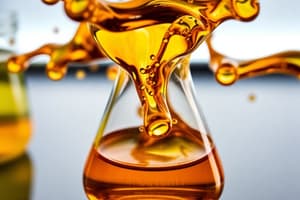Podcast
Questions and Answers
What is the driving force of a spontaneous process, according to the text?
What is the driving force of a spontaneous process, according to the text?
- Decrease in volume
- Dispersion of matter and energy (correct)
- Reduction in entropy
- Increase in temperature
According to the Boltzmann formula of Entropy, what does 'W' represent?
According to the Boltzmann formula of Entropy, what does 'W' represent?
- Number of particles
- Number of microstates (correct)
- Specific configuration of particles
- Boltzmann constant
In the context of microstates, what does 'n' stand for in the expression W = nN?
In the context of microstates, what does 'n' stand for in the expression W = nN?
- Number of states
- Number of particles
- Number of boxes (correct)
- Number of configurations
What happens to heat according to the text when two objects at different temperatures are in contact?
What happens to heat according to the text when two objects at different temperatures are in contact?
What effect does greater, more uniform dispersal of matter and energy have on a spontaneous process?
What effect does greater, more uniform dispersal of matter and energy have on a spontaneous process?
Which of the following best describes a spontaneous process?
Which of the following best describes a spontaneous process?
If a reaction is spontaneous in one direction, what can be said about its reverse direction?
If a reaction is spontaneous in one direction, what can be said about its reverse direction?
What distinguishes a non-spontaneous reaction?
What distinguishes a non-spontaneous reaction?
What relationship exists between the rate of a reaction and its spontaneity?
What relationship exists between the rate of a reaction and its spontaneity?
What is a common characteristic of many spontaneous reactions?
What is a common characteristic of many spontaneous reactions?
What defines the reference point for the Third Law of Thermodynamics?
What defines the reference point for the Third Law of Thermodynamics?
What is the relationship between the phase of a substance and its entropy?
What is the relationship between the phase of a substance and its entropy?
At what temperature does the Third Law of Thermodynamics state that the entropy of a pure perfect crystalline substance is zero?
At what temperature does the Third Law of Thermodynamics state that the entropy of a pure perfect crystalline substance is zero?
What are the units of entropy?
What are the units of entropy?
How can the entropy change of a reaction be obtained?
How can the entropy change of a reaction be obtained?
What is the relationship between the most probable distribution and the number of microstates?
What is the relationship between the most probable distribution and the number of microstates?
According to Hess’s Law, what is the relationship between the total change in entropy and stepwise processes?
According to Hess’s Law, what is the relationship between the total change in entropy and stepwise processes?
What does ΔSsys represent in the context of entropy changes?
What does ΔSsys represent in the context of entropy changes?
In the context of entropy changes, how is ΔSsys calculated alternatively?
In the context of entropy changes, how is ΔSsys calculated alternatively?
Which historical figure made groundbreaking discoveries about spontaneous heat flow based on Carnot's findings?
Which historical figure made groundbreaking discoveries about spontaneous heat flow based on Carnot's findings?
Flashcards are hidden until you start studying
Study Notes
Driving Forces of Spontaneous Processes
- Spontaneous processes are driven by increases in entropy, favoring the dispersal of matter and energy.
- A spontaneous reaction moves toward a state of higher disorder.
Boltzmann Formula and Microstates
- In the Boltzmann formula, 'W' represents the number of microstates corresponding to a macrostate.
- In the expression W = nN, 'n' indicates the number of particles or subsystems, while 'N' is the total number of microstates.
Heat Transfer and Temperature
- When two objects at different temperatures come into contact, heat flows from the hotter object to the cooler one until thermal equilibrium is achieved.
Effects of Matter and Energy Distribution
- A greater, more uniform dispersal of matter and energy enhances the spontaneity of a process, leading it to occur more readily.
Characteristics of Spontaneous Processes
- A spontaneous process occurs without external influence, often characterized by an overall decrease in free energy.
Reversibility of Spontaneous Reactions
- If a reaction is spontaneous in one direction, its reverse direction is non-spontaneous.
Non-Spontaneous Reactions
- Non-spontaneous reactions require external energy input to occur, highlighting a lack of natural tendency to progress.
Reaction Rate vs. Spontaneity
- The rate of a reaction is independent of its spontaneity; a spontaneous reaction may proceed quickly or slowly.
Common Traits of Spontaneous Reactions
- Many spontaneous reactions are exothermic, releasing energy, although endothermic reactions can also be spontaneous if entropy increases sufficiently.
Third Law of Thermodynamics Reference Point
- The reference point for the Third Law of Thermodynamics is the state of a perfect crystalline substance at absolute zero.
Phase and Entropy Relationship
- The phase of a substance influences its entropy, with gases typically having higher entropy than liquids or solids due to greater molecular disorder.
Absolute Zero and Entropy
- At absolute zero (0 Kelvin), the entropy of a pure perfect crystalline substance is defined to be zero.
Units of Entropy
- The standard unit of entropy is joules per kelvin (J/K).
Calculating Entropy Change
- The entropy change of a reaction can be obtained from standard entropy values or calculated using ΔS = S_final - S_initial.
Microstates and Most Probable Distribution
- The most probable distribution corresponds to the maximum number of microstates accessible to a system, indicating higher entropy.
Hess's Law and Entropy Changes
- According to Hess’s Law, the total change in entropy for a reaction is the sum of the entropy changes in each step of the process.
ΔSsys in Entropy Changes
- ΔSsys represents the change in entropy of the system, providing insight into how energy dispersal evolves throughout a reaction.
Alternative Calculation of ΔSsys
- ΔSsys can also be calculated alternatively by considering the heat exchange divided by the temperature at which the exchange occurs.
Historical Contributions to Thermodynamics
- Significant discoveries about spontaneous heat flow were made by Sadi Carnot, laying foundational principles in thermodynamics.
Studying That Suits You
Use AI to generate personalized quizzes and flashcards to suit your learning preferences.




